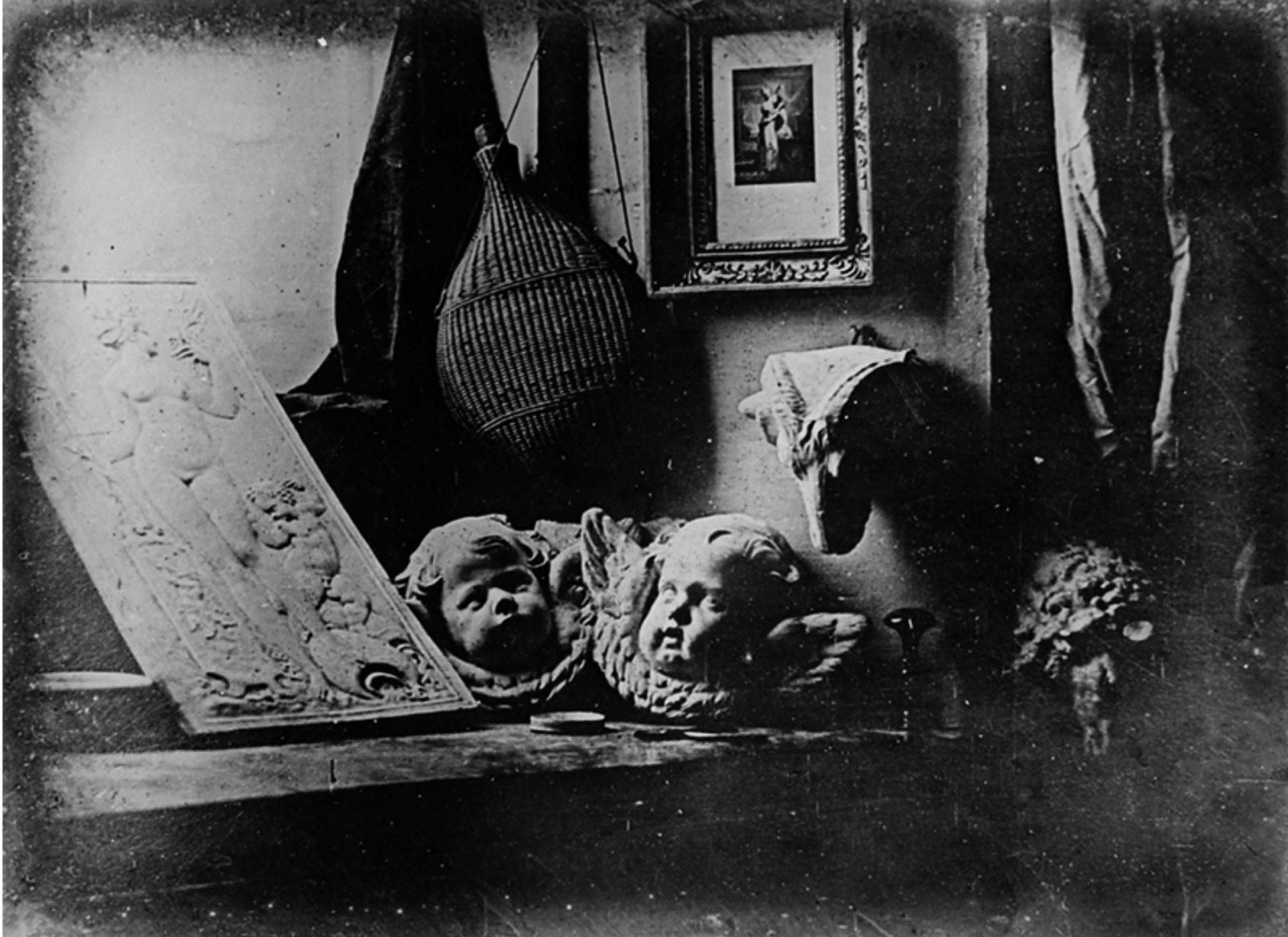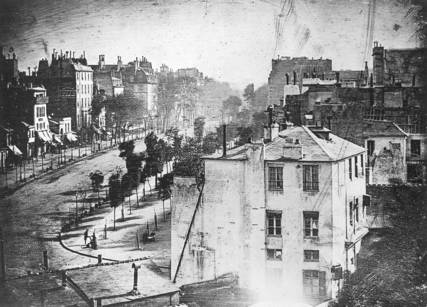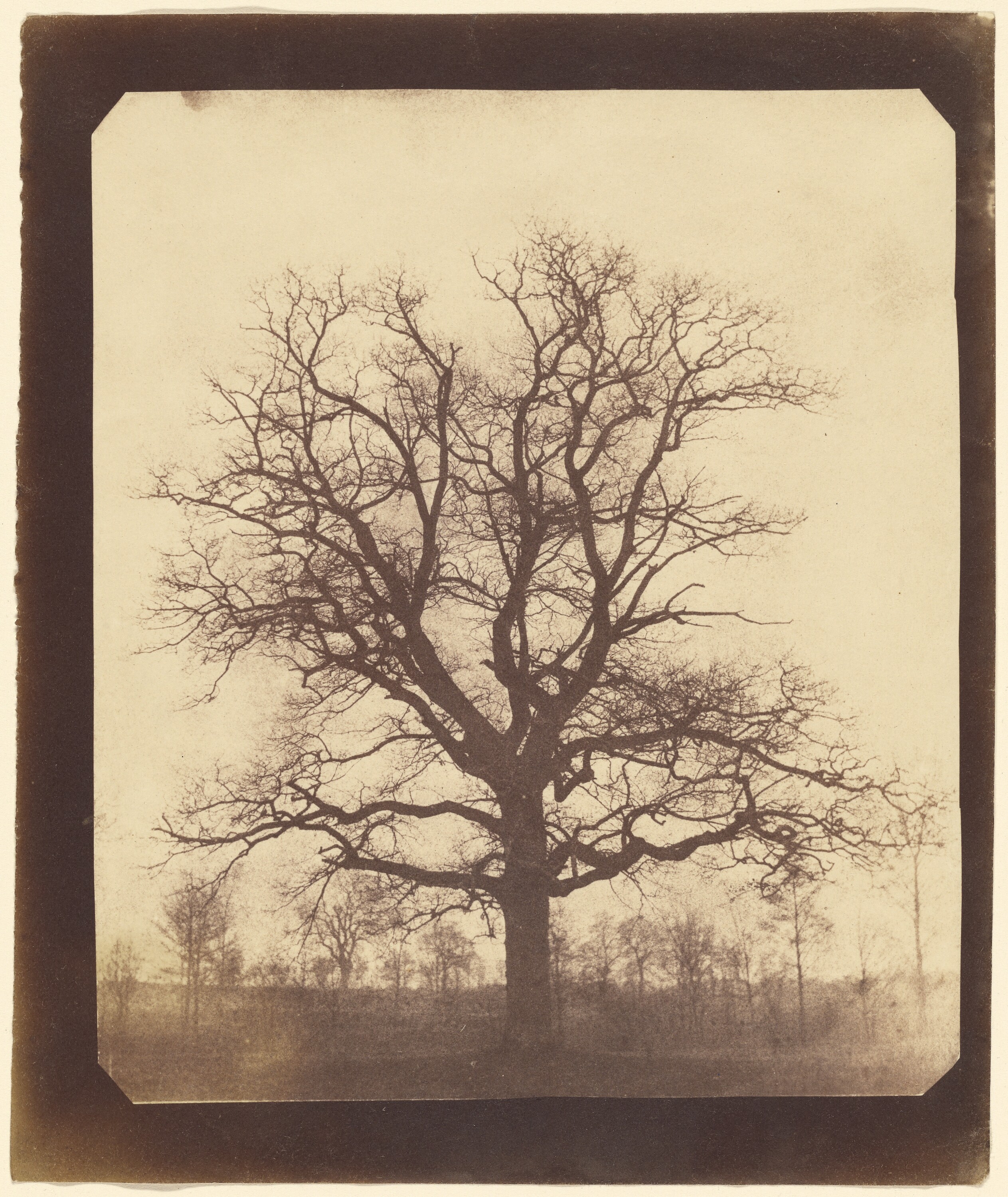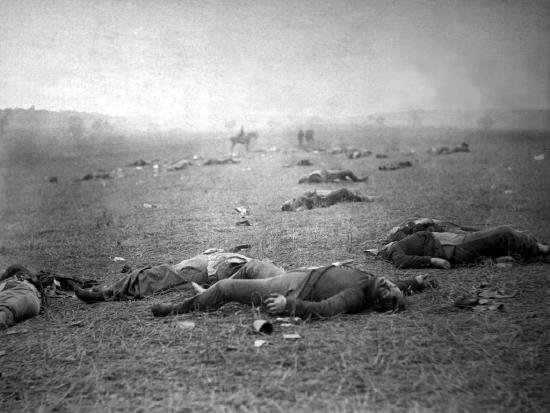4.5: Photography
- Page ID
- 156874
Overview
The word photography derives from Greek, “writing with light". Camera obscura (Latin for dark room) used for centuries as an aid to drawing. In the 1800s, inventors found ways to make images permanent (fixed); Daguerreotype, Calotype, Cyanotype. Invention of digital cameras c. 1980s.
EARLY DEVELOPMENT
The Birth of Photography
- Although the principle of the camera was known in antiquity, the actual chemistry needed to register an image was not available until the nineteenth century.
- Artists from the Renaissance onwards used a camera obscura (Latin for dark chamber), or a small hole in the wall of a darkened box that would pass light through the hole and project an upside-down image of whatever was outside the box. However, it was not until the invention of a light sensitive surface by Frenchman Joseph Nicéphore Niépce that the basic principle of photography was born.
- From this point the development of photography largely related to technological improvements in three areas, speed, resolution and permanence. The first photographs, such as Niepce’s famous View from the Window at Gras (1826) required a very slow speed (a long exposure period), in this case about eight hours, obviously making many subjects difficult, if not impossible, to photograph. Taken using a camera obscura to expose a copper plate coated in silver and pewter, Niepce’s image looks out of an upstairs window, and part of the blurry quality is due to changing conditions during the long exposure time, causing the resolution, or clarity of the image, to be grainy and hard to read. An additional challenge was the issue of permanence, or how to successfully stop any further reaction of the light-sensitive surface once the desired exposure had been achieved. Many of Niepce’s early images simply turned black over time due to continued exposure to light. This problem was largely solved in 1839 by the invention of hypo, a chemical that reversed the light sensitivity of paper.

Louis-Jacques-Mandé Daguerre, The Artist’s Studio / Still Life with Plaster Casts, 1837, daguerreotype (photography), 6.5 inches by 8.5 inches (public domain)
Camera obscura

Optics: the principle of the camera obscura, 1752. Engraving, 3¾ × 6½". Public Domain Mark
- Photography is a controversial fine art medium, simply because it is difficult to classify—is it an art or a science? Nineteenth-century photographers struggled with this distinction, trying to reconcile aesthetics with improvements in technology.
- The first attempts to capture an image were made from a camera obscura, used since the 16th century.
- The device consists of a box or small room with a small hole in one side that acts as a lens.
- Light from an external scene passes through the hole and strikes the opposite surface inside where it is reproduced upside-down, but with color and perspective preserved.
- The image is usually projected onto paper adhered to the opposite wall, and can then be traced to produce a highly accurate representation. Experiments in capturing images on film had been conducted in Europe since the late 18th century.
Chemically Fixing the Image
- Using the camera obscura as a guide, early photographers found ways to chemically fix the projected images onto plates coated with light-sensitive materials.
- Moreover, they installed glass lenses in their early cameras and experimented with different exposure times for their images.
- By modern standards, nineteenth-century photography can appear rather primitive. While the stark black and white landscapes and unsmiling people have their own austere beauty, these images also challenge our notions of what defines a work of art.
- View from the Window at Le Gras is one of the oldest existing photographs, taken in 1826 by French inventor Joseph Niepce using a process he called heliograpy (“helio” meaning sun and “graph” meaning write).
- The exposure for the image took eight hours, resulting in the sun casting its light on both sides of the houses in the picture.
- Further developments resulted in apertures– thin circular devices that are calibrated to allow a certain amount of light onto the exposed film. Apertures allowed photographers better control over their exposure times.

Joseph Nicéphore Niépce, View from the Window at Le Gras, c. 1826. Gernsheim Collection, Harry Ransom Humanities Research Center, University of Texas at Austin. Public domain
Daguerreotypes
- Photographers after Niepce experimented with a variety of techniques. Louis Daguerre invented a new process he dubbed a daguerrotype in 1839, which significantly reduced exposure time and created a lasting result, but only produced a single image.
William Henry Fox Talbot, The Open Door, 1844, Salted paper print from paper negative. Public domain
- During the 1830’s Louis Daguerre, having worked with Niepce earlier, developed a more reliable process to capture images on film by using a polished copper plate treated with silver.
- He termed the images made by this process “Daguerreotypes”.
- They were sharper in focus and the exposure times were shorter.
- His photograph Boulevard du Temp from 1838 is taken from his studio window overlooking a busy Paris street. Still, with an exposure of ten minutes, none of the moving traffic or pedestrians (One exception. See if you can find it!) stayed still long enough to be recorded.

Louis Daguerre, Boulevard du Temps, 1838. Image in the public domain
Collodion
The collodion method was introduced in 1851. This process involved fixing a substance known as gun cotton onto a glass plate, allowing for an even shorter exposure time (3–5 minutes), as well as a clearer image.
The big disadvantage of the collodion process was that it needed to be exposed and developed while the chemical coating was still wet, meaning that photographers had to carry portable darkrooms to develop images immediately after exposure. Both the difficulties of the method and uncertain but growing status of photography were lampooned by Honore Daumier in his Nadar Elevating Photography to the Height of Art (1862). Nadar, one of the most prominent photographers in Paris at the time, was known for capturing the first aerial photographs from the basket of a hot air balloon. Obviously, the difficulties in developing a glass negative under these circumstances must have been considerable.
Calotypes
- At the same time in England, William Henry Fox Talbot was experimenting with other photographic processes.
- He was creating photogenic drawings by simply placing objects (mostly botanical specimens) over light sensitive paper or plates, then exposing them to the sun.
- By 1844 he had invented the calotype; a photographic print made from a negative image.
- In contrast, Daguerreotypes were single, positive images that could not be reproduced. Talbot’s calotypes allowed for multiple prints from one negative, setting the standard for the new medium.
- Though Daguerre won the race to be first in releasing his photographic process, Talbot’s negative to positive process would eventually become the dominant process.

William Henry Fox Talbot, Oak Tree in Winter. Left: Calotype, c. 1842–43; and Right: salted paper print, c. 1892–93. Public domain
Impact of Photography on Other Media
- The advent of photography caused a realignment in the use of other two-dimensional media.
- The photograph was now in direct competition with drawing, painting and printmaking.
- The camera turns its gaze on the human narrative that stands before it. The photograph gave (for the most part), a realistic and unedited view of our world.
- In its early beginning, photography was considered to offer a more “true” image of nature because it was created mechanically, not by the subjective hand of an artist. Its use as a tool for documentation was immediate, which gave the photo a scientific role to play.
- The sequential, instantaneous exposures by Eadweard Muybridge helped to understand human and animal movement, but also highlighted that photography could be used to expand human vision, imaging something that could not be seen with the naked eye.
- The relative immediacy and improved clarity of the photographic image quickly pitted the camera against painting in the genre of portraiture.
- Before photography, painted portraits were afforded only to the wealthy and most prominent members of society. They became symbols of social class distinctions. Now portraits became available to individuals and families from all social levels.
Photography as an Art
- It wasn’t long before photographers recognized the aesthetic value of a photograph.
- As a new medium, photography began the march towards being considered a high form of art.
- Alfred Stieglitz understood this potential, and as a photographer, editor and gallery owner, was a major force in promoting photography as an art form.
- He led in forming the Photo Secession in 1902, a group of photographers who were interested in defining the photograph as an art form in itself, not just by the subject matter in front of the lens. Subject matter became a vehicle for an emphasis on composition, lighting and textural effects.
- His own photographs reflect a range of themes. The Terminal (1892) is an example of “straight photography”: images from the everyday taken with smaller cameras and little manipulation.
- In The Terminal Stieglitz captures a moment of bustling city street life on a cold winter day. The whole cold, gritty scene is softened by steam rising off the horses and the snow provides highlights. But the photo holds more than formal aesthetic value.
- The jumble of buildings, machines, humans, animals and weather conditions provides a glimpse into American urban culture straddling two centuries. Within ten years from the time this photo was taken horses will be replaced by automobiles and subway stations will transform a large city’s movement into the twentieth century.
Photojournalism and photography’s many subject placements
Photography is a medium that has multiple subject placements.
- It is used as an art medium, in journalism, in advertising, the fashion industry, and we use it to personally document our lives.
- It is one, if not the most, pervasive form of documentation in the world.
- These multiple subject placements make it a complex phenomena to analyze.
- The news industry was fundamentally changed with the invention of the photograph. Although pictures were taken of newsworthy stories as early as the 1850’s, the photograph needed to be translated into an engraving before being printed in a newspaper.
- It wasn’t until the turn of the nineteenth century that newspaper presses could copy original photographs. Photos from around the world showed up on front pages of newspapers defining and illustrating stories, and the world became smaller as this early mass medium gave people access to up to date information…with pictures!
Photojournalism is a particular form of journalism that creates images in order to tell a news story and is defined by these three elements:
- Timeliness — the images have meaning in the context of a recently published record of events.
- Objectivity — the situation implied by the images is a fair and accurate representation of the events they depict in both content and tone.
- Narrative — the images combine with other news elements to make facts relatable to the viewer or reader on a cultural level.
- As visual information, news images help in shaping our perception of reality and the context surrounding them.
- Photographs taken by Mathew Brady and Timothy O’Sullivan during the American Civil War (below) gave sobering witness to the carnage it produced. Images of soldiers killed in the field help people realize the human toll of war and desensitize their ideas of battle as being particularly heroic.

“The Harvest of Death” Union dead on the battlefield at Gettysburg, Pennsylvania, photographed July 5–6, 1863. Image in Public Domain. Available through US Library of Congress
- Photojournalism’s “Golden Age” took place between 1930 and 1950, coinciding with advances in the mediums of radio and television.
- Dorothea Lange was employed by the federal government’s Farm Security Administration to document the plight of migrant workers and families dislocated by the Dust Bowl and the Great Depression in America during the 1930’s. Migrant Mother, Florence Owens Thompson, Nipomo Valley, California is an iconic image of its hardships and the human resolve to survive.
- Like O’Sullivan’s civil war photos, Lange’s picture puts a face on human tragedy. Photographs like this helped win continued support for President Franklin Roosevelt’s social aid programs.

Dorothea Lange, Migrant Mother, 1936. Library of Congress, Washington, D.C. The Alfred and Ingrid Lenz Harrison Fund
Minneapolis Institute of Arts (Minneapolis, MN, USA)
Sources
- Debra J. DeWitte, Ralph M. Larmann, and M. Kathryn Shields. Gateways to Art: Understanding the Visual Arts, Third Edition.

